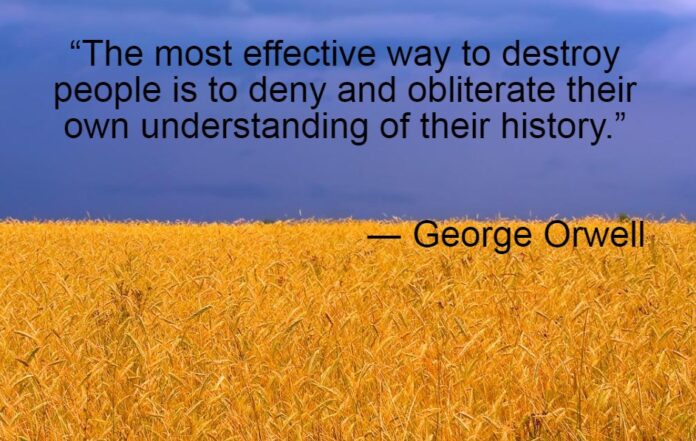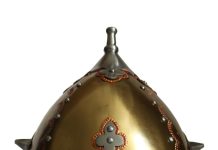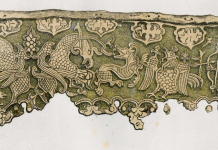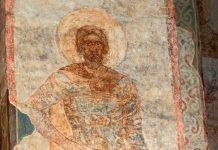There are probably not so many people, especially of the elder generation, who have not watched the 1990 movie ‘Total Recall’ with Arnold Schwartzenegger and Sharon Stone. The science fiction film tells the story of a construction worker Douglas Quaid who lives in 2084 and is married to Lori. From time to time, Douglas has troubling dreams about the planet Mars and another woman. At the time, there is a rebellion on that planet against the rule of its authoritarian governor Vilos Cohaagen played by Ronny Cox. Quaid visits a company that implants false vacation memories and chooses a “trip” to Mars as a secret agent. The procedure suddenly reveals that Quaid’s dreams were actual experiences of a secret agent at Mars. Although the employees of the firm erase his memory again, on the way home Quaid’s colleagues try to kill him. After killing them in self-defense, at home, his wife Lori attempts to kill him as well. Despite its fictional plot, the film portrays a real-life truth – certain memories of the past can be dangerous and even deadly. It is true for individuals, for groups of people. It can be true even for nations.
In a sense, Ukraine also had a memory implant full of false narratives of its history – ‘Little Russia‘, ‘younger brother‘ are just a couple examples. And at the times when true memory was about to return to Ukraine, attempts were made to erase it. Mostly through the killings of Ukraine’s historians and politicians, but other groups as well.
Let us hear the view of someone authoritative on the subject, someone not biased. First, about the authority of a man we are about to quote. In 1943, this man coined the very term ‘Genocide‘. In 1951, the man initiated the Convention on the Prevention and Punishment of the Crime of Genocide which became effective in 1953. As for another requirement, the man was a Polish lawyer of Jewish descent and these facts can indicate that there were no obvious reasons for him to favor Ukraine or Ukrainians. The man’s name was Raphael Lemkin.
In his 1953 New York speech devoted to Holodomor The Soviet Genocide in Ukraine, he said the following:
“What I want to speak about is perhaps the classic example of Soviet genocide, its longest and broadest experiment in Russification — the destruction of the Ukrainian nation.”
For a man with tremendous expertise in the field, Holodomor was the classic example of genocide. And he names the four groups that were the primary targets for elimination:
“The nation is too populous to be exterminated completely with any efficiency. However, its leadership, religious, intellectual, political, its select and determining parts, are quite small and therefore easily eliminated, and so it is upon these groups particularly that the full force of the Soviet axe has fallen, with its familiar tools of mass murder, deportation and forced labour, exile and starvation. The attack has manifested a systematic pattern, with the whole process repeated again and again to meet fresh outbursts of national spirit.“
The first blow, in Dr. Lemkin’s opinion, was aimed at the intelligentsia, “the national brain, so as to paralyse the rest of the body”:
“In 1920, 1926 and again in 1930–1933, teachers, writers, artists, thinkers, political leaders, were liquidated, imprisoned or deported. According to the /Ukrainian Quarterly/ of Autumn 1948, 51,713 intellectuals were sent to Siberia in 1931 alone. At least 114 major poets, writers and artists, the most prominent cultural leaders of the nation, have met the same fate. It is conservatively estimated that at least 75% of the Ukrainian intellectuals and professional men in Western Ukraine, Carpatho–Ukraine and Bukovina have been brutally exterminated by the Russians“
Another offensive was against the churches, priests and hierarchy, the ‘soul’ of Ukraine:
“Between 1926 and 1932, the Ukrainian Orthodox Autocephalous Church, its Metropolitan Lypkivsky and 10,000 clergy were liquidated. In 1945, when the Soviets established themselves in Western Ukraine, a similar fate was meted out to the Ukrainian Catholic Church.“
“The third prong of the Soviet plan was aimed at the farmers, the large mass of independent peasants who are the repository of the tradition, folklore and music, the national language and literature, the national spirit, of Ukraine. The weapon used against this body is perhaps the most terrible of all — starvation. Between 1932 and 1933, 5,000,000 Ukrainians starved to death.”
The toil was actually closer to 7 million people, and to those who still repeat Russia’s narrative of a “bad harvest”, Dr. Lemkin says the following lines:
“The crop that year was ample to feed the people and livestock of Ukraine, though it had fallen off somewhat from the previous year, a decrease probably due in large measure to the struggle over collectivization. But a famine was necessary for the Soviet and so they got one to order, by plan, through an unusually high grain allotment to the state as taxes.”
“The fourth step in the process consisted in the fragmentation of the Ukrainian people at once by the addition to the Ukraine of foreign peoples and by the dispersion of the Ukrainians throughout Eastern Europe. In this way, ethnic unity would be destroyed and nationalities mixed. Between 1920 and 1939, the population of Ukraine changed from 80% Ukrainian to only 63%. In the face of famine and deportation, the Ukrainian population had declined absolutely from 23.2 million to 19.6 million, while the non-Ukrainian population had increased by 5.6 million. When we consider that Ukraine once had the highest rate of population increase in Europe, around 800,000 per year, it is easy to see that the Russian policy has been accomplished.”
Moscow brought Russians to Ukraine by tens of trains. The newcomers often settled in the houses of Ukrainian farmers who had died during Holodomor.
One may wonder about the reason for these horrible actions of Moscow toward Ukraine. Especially at this very moment when Russia has more than 100,000 troops on Ukrainian borders ready for it next attempt to destroy Ukraine.
The true reason, omitted by many, was named by Putin in his “Crimean speech” on March 18, 2014 – it is all about HISTORY. And stolen identity.
“Everything in Crimea speaks of our shared history and pride. This is the location of ancient Khersones, where Prince Vladimir was baptized. His spiritual feat of adopting Orthodoxy predetermined the overall basis of the culture, civilization, and human values that unite the peoples of Russia, Ukraine, and Belarus.”
In the eyes of those who listened to this passage, it must have been a spiritual feat for a three times larger country to annex that sacred place from a smaller one! What a Christian virtue! What a basis for unity!
In an attempt to at least somehow justify the crime, Putin blamed Ukrainian Euromaidan and “forces” that “executed this coup”.
Because the “coup” narrative keeps popping up in the speeches of Russian propagandists, here is a quick rebuttal. The Constitutional system of Ukraine is Parliamentary-Presidential, meaning that Parliament comes first, then goes the President. In 2014, although President Yanukovych fled, the Parliament of Ukraine stayed functional.
But do you know what really looks like a coup? It is the shelling of the building of the Russian Parliament in Moscow in 1993. It happened because President Yeltsin intended to dissolve the Congress of People’s Deputies and parliament based on the results of the referendum of April 1993, although the Constitution did not give the President the power to do so.
But returning to the “cultural unity” and “one people” narrative propagated by Russian media and authorities worldwide. Surprisingly, the difference between Ukrainians and Russians was obvious to any unbiased observer.
Raphael Lemkin in the speech quoted above stated the following:
“…the Ukrainian is not and has never been, a Russian. His culture, his temperament, his language, his religion — all are different.”
In 1810, a book written by Dr. Edward Clark ‘Travels in Russia, Tartary, and Turkey’ became a European bestseller and would be reprinted four more times. It is in fact a diary of his trip from St. Petersburg to the Azov Sea. Somewhere in the area of the present-day Donetsk region, Dr. Clark encountered Ukrainians for the first time. He referred to them as the Malo-Russians, and here are his first impressions:
“We met frequent caravans of the Malo-Russians, who differ altogether from the inhabitants of the rest of Russia. Their features are those of the Polonese or Cossacks. They are a much more noble race, and stouter and better-looking people than the Russians… We began to perceive that the farther we advanced from the common hordes of the Russians, the more politeness and hospitality we should experience; exactly the reverse of that which we had been taught to expect by the inhabitants of Moscow.”
One of the most distinctive features of Ukrainians observed by E. Clark in Ukrainians was cleanliness:
“We proceeded from Paulovskoy to Kazinskoy Chutor, a village inhabited by Malo-Russians and Russians mingled together. The distinction between the two people might be made without the smallest inquiry, from the striking contrast between filth and cleanliness.”
A house of a poor superintendent villager so impressed the English travelers that Dr. Clark wrote that he would rather have dined on the floor of that apartment than “on the table of any Russian prince.”
The second feature noted in Ukrainians by the traveler was their honesty:
“Concerning the inhabitants of the country called Malo-Russia, a French gentleman, who had long resided among them, assured me he used neither locks to his doors nor to his coffers; and among the Cossacks, as in Sweden, a trunk may be sent open, for a distance of 500 miles, without risking the loss of any of its contents.”
The last quote is extremely important because Russian propaganda made a great effort over the decades to present Ukrainians as inherently corrupt. It is not so. The corruption was brought into Ukraine from without.
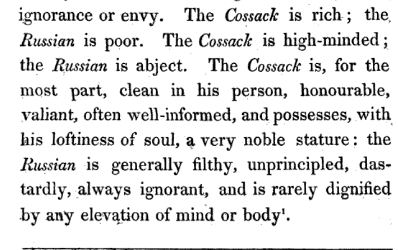
In 1947, already famous John Steinbeck landed in Kyiv. It is amazing, but almost 150 years after Edward Clark, he noted exactly the same features in the Ukrainians as the English traveler did:
“Everyone had told us it would be different once we got outside of Moscow, that the sternness and the tenseness would not exist. And this was true. On the airfield we were met by a number of Ukrainians from the local Voks. They were laughing people. They were more cheerful and more relaxed than the men we had met in Moscow. There was an openness and a heartiness about them. They were big men, nearly all blond, with gray eyes…”
“Although Kiev is greatly destroyed while Moscow is not, the people in Kiev did not seem to have the dead weariness of the Moscow people. They did not slouch when they walked, their shoulders were back, and they laughed in the streets. Of course this might be local, for the Ukrainians are not like the Russian; they are a separate species of Slav.”
It is during this trip to Ukraine that John Steinbeck tried to let the Americans know what price Ukraine paid in WW2. He wrote:
“If the United States were completely destroyed from New York to Kansas, we would have about the area of destruction the Ukraine has. If six million people were killed, not counting soldiers, fifteen per cent of the population, you would have an idea of the casualties of the Ukraine.”
John Steinbeck even noted certain peculiarities of the Ukrainian language:
“And while most Ukrainians can speak and read Russian, their own language is a language apart and separate, nearer to the Southern Slavic languages than to Russian. Many Ukrainian words, particularly farm words, are the same as in Hungarian, and many of their words are duplicated in Czech rather than in Russian…”
And here is a possible shocker for some – the Russians are not “a separate species of Slav” as the great writer supposed – they are the Ugro-Finns.
And here is a simple fact. Count Alexey Uvarov, who is considered to be the founder of the study of the prehistory of Russia, excavated 7729 kurgans in the area corresponding roughly to the “Golden Ring” around Moscow. The burials covered the time period from the 8th century to the 16th century AD. To his surprise, he did not discover a single Slavic burial. Not one! Uvarov summarized his findings in The Meryans and Their Lifestyle as Shown by Kurgan Excavations.
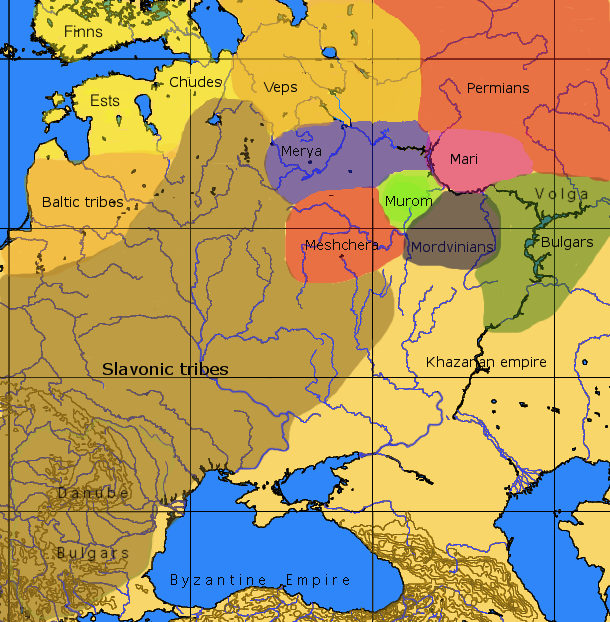
There is a strong testimony that the land of the Meryans was not part of Rus in the middle of the 13th century. After the Mongol invasion, in 1254, a French king and a Pope sent one sent their emissary to Batu Khan, who had his camp at the Volga river. The emissary was Friar William of Rubruck, one of the most educated people of that time.
Here is what Rubruck recorded during his travels:
“The country beyond the Tanais (Don) is most beautiful, with rivers and forests. To the north are great forests, inhabited by two races of men: to wit, the Moxel, who are without any religion, a race of pure pagans. They have no towns, but only little hamlets in the forest. Their chief and the greater part of them were killed in Germany; for the Tartars took them with them to the borders of Germany.”
The footnotes by the editors of ‘The Journey to the Eastern Parts of the World‘ make the comment: “The Moxel and Merdas form the two branches of the Finnish Mordvin people. These names, according to Pallas (Voyages), correctly transcribed are Mokshad and Ersad, the first name being applied by them to their race in general”, so there is no doubt that the Friar describes the same Meryan land.
Mokshas is the name Ukrainians call Russians these days as well.
The important point mentioned by Rubruck should not be missed – the Moxel, the Mokshas became a part of the Golden Horde attacking Europe immediately after the invasion. As Rubruck reported, a lot of them died in Germany fighting in the ranks of the Mongols.
Harvard Professor Richard Pipes in his book ‘Russia Under the Old Regime’ reveals some more facts about the history of that formation:
“Moscow passed to Ivan Danilovich later designated Ivan 1 of Russia. The new ruler proved an extraordinarily gifted and unscrupulous political manipulator. By one scholar’s estimate, he spent most of his reign either at Sarai (Golden Horde’s capital on the Volga) or en route to or from it, which gives some idea how busy he must have been intriguing there.”
“In 1327, the population of Tver rose against the Mongols and massacred a high-level deputation sent from Sarai to oversee the collection of the tribute. After some hesitation, the prince of Tver sided with the rebels. As soon as this news had reached him, Ivan left for Sarai. He returned as the head of a combined Mongol-Russian punitive force which so devastated Tver and a great deal of central Russia besides that the region was not yet fully recovered half a century later. As a reward for his loyalty, the Mongols invested Ivan with the title of Great Prince and appointed him Farmer General of the tribute throughout Russia.”
That spirit of Farmer General of the tribute appears to be present in Moscow to this day. When one looks at a country run by a single person and where “the Parliament is not a place for discussions” as a speaker of the Russian Parliament (!) stated, one wonders if we see the replica of the Golden Horde in our days.
A quick note that 7 years before Ivan received that title, – in 1320, Kyiv had already expelled the Mongols with the help of the Lithuanian knights and became an integral part of the Great Duchy of Lithuania.
Moscow stole the identity of Kyiv and now when it gets gradually exposed, it does everything in its power to eliminate the true one whose legacy it tries to appropriate. Hence, the destruction of the Ukrainian history books together with historians. Hence, the theft of museum artifacts. Hence, the prohibition of the Ukrainian language. Hence, the genocide.
The winter of this year demonstrated clearly that Moscow is psychologically ready to easily risk the lives of millions of people to get what it wants when it shut down the gas supply to Europe. “Create the shortage (of gas. food) and extort what you need,” – appears to be the motto of Russia. In the ‘Total Recall‘ film, Vilos Cohaagen used the same technique to control the whole planet, only, in his case, it was oxygen. Symbolically, he died of the deficit he himself created. It would be very symbolic if Moscow repeated the pattern and collapsed because of the man-made catastrophe it prepared for others.
The “Gardariki, Ukraine” ebook has more facts about the true history of Kyiv Rus. It also answers all the possible questions about Novgorod.



